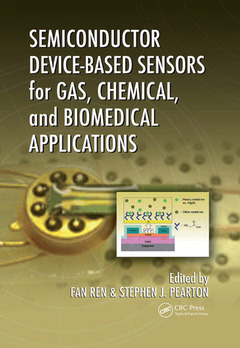Description
Semiconductor Device-Based Sensors for Gas, Chemical, and Biomedical Applications
Coordinators: Ren Fan, Pearton Stephen J
Language: English
Subjects for Semiconductor Device-Based Sensors for Gas, Chemical...:
Keywords
GaN HEMT; ZnO Nanorods; high; ZnO Nanowires; electron; Source Drain Current; mobility; Schottky Diodes; transistors; InN Surface; resolution; Ppm H2; energy; Drain Current; loss; Mem Fabrication; spectroscopy; Equivalent Circuit; gallium; Cell Line; nitride; GaN Heterostructures; Mn Dope ZnO; Hydrogen Sensor; Surface Electron Accumulation; TM; DI Water; EBC; MZI Sensor; Thioglycolic Acid; Cell Media; PNA Probe; GaN HEMT Structure; Bulk ZnO; ZnO Crystal
Publication date: 04-2017
· 17.8x25.4 cm · Paperback
Publication date: 06-2011
302 p. · 17.8x25.4 cm · Hardback
Description
/li>Contents
/li>Readership
/li>Biography
/li>
Sales of U.S. chemical sensors represent the largest segment of the multi-billion-dollar global sensor market, which includes instruments for chemical detection in gases and liquids, biosensors, and medical sensors. Although silicon-based devices have dominated the field, they are limited by their general inability to operate in harsh environments faced with factors such as high temperature and pressure.
Exploring how and why these instruments have become a major player, Semiconductor Device-Based Sensors for Gas, Chemical, and Biomedical Applications presents the latest research, including original theoretical and experimental work. It also explains how these investigations have translated into applications and products.
Written by experts in the field, the chapters review cutting-edge progress on semiconductor and nanomaterial-based sensors. An excellent introduction to the subject, this book is also an outstanding reference for those working on different sensor applications. It addresses various subfields, including:
- GaN-based sensor arrays for quick and reliable medical testing
- Optical sensors
- Wireless remote hydrogen sensing systems
- MOS-based, thin-film, and nanowire-based sensors
The wide-bandgap semiconductor sensors discussed in this book offer many advantages as replacements for silicon-based sensors, including their high chemical resistance, high-temperature operation, and blue and ultraviolet optoelectronic behaviors. Although assays exist for biomedical detection, they are limited by various factors. Nanomaterial devices, such as the sensors examined in this book, are currently the best option for moving toward fast, label-free, sensitive, and selective multiple-detection systems for biological and medical sensing applications. Providing sufficient background information and technical detail, this is an excellent resource for advanced level undergraduate and graduate students as well as researchers in gas, chemical, biological, and medical sensors.
AlGaN/GaN Sensors for Direct Monitoring of Nerve Cell Response to Inhibitors. Recent Advances in Wide Bandgap Semiconductor Biological and Gas Sensors. Advances in Hydrogen Gas Sensor Technology and Implementation in Wireless Sensor Networks. InN-Based Chemical Sensors. ZnO Thin Film and Nanowire Based Sensor Applications. Bio-Affinity Sensors Based on MOS Field-Effect Transistors. MEMS-Based Optical Chemical Sensors.
Fan Ren works with the University of Florida, Gainesville.
Stephen J. Pearton works with the University of Florida, Gainesville.




